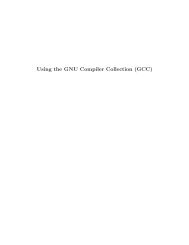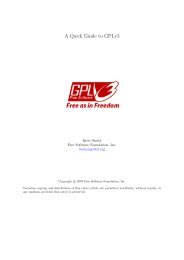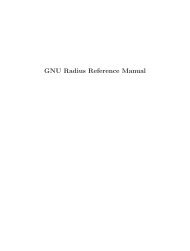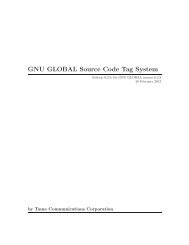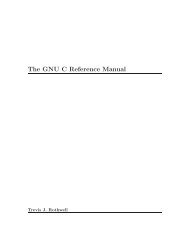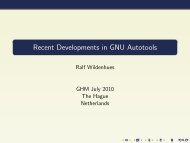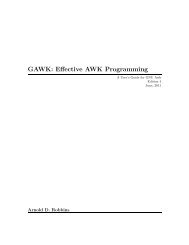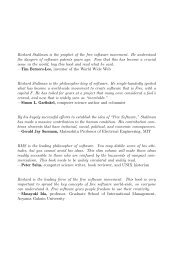by Trent A. Fisher and Werner Lemberg - The GNU Operating System
by Trent A. Fisher and Werner Lemberg - The GNU Operating System
by Trent A. Fisher and Werner Lemberg - The GNU Operating System
Create successful ePaper yourself
Turn your PDF publications into a flip-book with our unique Google optimized e-Paper software.
40 <strong>The</strong> <strong>GNU</strong> Troff Manual<br />
4.3.5.2 Headings<br />
Use headings to create a hierarchical structure for your document. <strong>The</strong> ‘ms’<br />
macros print headings in bold, using the same font family <strong>and</strong> point size as<br />
the body text.<br />
<strong>The</strong> following describes the heading macros:<br />
.NH curr-level<br />
[Macro]<br />
.NH S level0 . . .<br />
[Macro]<br />
Numbered heading. <strong>The</strong> argument is either a numeric argument to indicate<br />
the level of the heading, or the letter S followed <strong>by</strong> numeric arguments<br />
to set the heading level explicitly.<br />
If you specify heading levels out of sequence, such as invoking ‘.NH 3’<br />
after ‘.NH 1’, groff prints a warning on st<strong>and</strong>ard error.<br />
\*[SN]<br />
[String]<br />
\*[SN-DOT]<br />
[String]<br />
\*[SN-NO-DOT]<br />
[String]<br />
After invocation of NH, the assigned section number is made available in<br />
the strings SN-DOT (as it appears in a printed section heading with default<br />
formatting, followed <strong>by</strong> a terminating period), <strong>and</strong> SN-NO-DOT (with the<br />
terminating period omitted). <strong>The</strong> string SN is also defined, as an alias for<br />
SN-DOT; if preferred, you may redefine it as an alias for SN-NO-DOT, <strong>by</strong><br />
including the initialization<br />
.als SN SN-NO-DOT<br />
at any time before you would like the change to take effect.<br />
\*[SN-STYLE]<br />
[String]<br />
You may control the style used to print section numbers, within numbered<br />
section headings, <strong>by</strong> defining an appropriate alias for the string SN-STYLE.<br />
<strong>The</strong> default style, in which the printed section number is followed <strong>by</strong> a<br />
terminating period, is obtained <strong>by</strong> defining the alias<br />
.als SN-STYLE SN-DOT<br />
If you prefer to omit the terminating period, from section numbers appearing<br />
in numbered section headings, you may define the alias<br />
.als SN-STYLE SN-NO-DOT<br />
Any such change in section numbering style becomes effective from the<br />
next use of .NH, following redefinition of the alias for SN-STYLE.<br />
.SH [match-level]<br />
[Macro]<br />
Unnumbered subheading.<br />
<strong>The</strong> optional match-level argument is a <strong>GNU</strong> extension. It is a number<br />
indicating the level of the heading, in a manner analogous to the currlevel<br />
argument to .NH. Its purpose is to match the point size, at which<br />
the heading is printed, to the size of a numbered heading at the same<br />
level, when the GROWPS <strong>and</strong> PSINCR heading size adjustment mechanism<br />
is in effect. See Section 4.3.3 [ms Document Control Registers], page 33.



